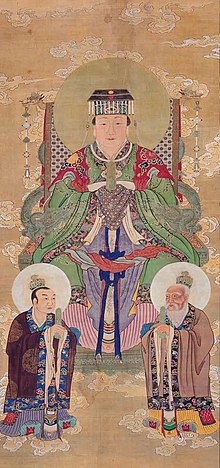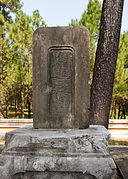Houtu
This articlemay be a roughtranslationfrom another language.It may have been generated, in whole or in part, by a computer or by a translator without dual proficiency.(October 2023) |
This articlemay requirecopy editingfor grammar, style, cohesion, tone, or spelling.(October 2023) |
| Houtu | |||||||||||||
|---|---|---|---|---|---|---|---|---|---|---|---|---|---|
 | |||||||||||||
| Chinese name | |||||||||||||
| Chinese | Hậu thổ | ||||||||||||
| Literal meaning | Queen of the Earth | ||||||||||||
| |||||||||||||
| Japanese name | |||||||||||||
| Kanji | Hậu thổ | ||||||||||||
| Kana | こうど | ||||||||||||
| |||||||||||||
| Part ofa serieson |
| Taoism |
|---|
 |
Hòutǔ(Chinese:Hậu thổ;lit.'Queen of the Earth') orHòutǔshén(Hậu thổ thần;'Goddess Queen of the Earth'), alsoHòutǔ Niángniáng(in Chinese eitherHậu thổ nương nương;'Deep Earth Lady' orHậu thổ nương nương;'Earth Queen Lady'), otherwise calledDimǔ(Mà mẫu;'Mother Earth') orDimǔ Niángniáng(Mà mẫu nương nương;'Lady Mother Earth'), is thedeityof all land and earth inChinese religionandmythology.[1]Houtuis the overlord of all theTudigongs( "Lord of Local Land" ),Sheji( "the State" ),Shan Shen( "God of Mountains" ),City Gods( "God of Local City" ), andlandlord godsworldwide.
InTaoism,Houtu is one of theFour Heavenly Ministers,which are four of the highest-ranking gods in Taoism.
Role[edit]
Houtu was originally the god of all land and earth in early Chinese mythology, before being absorbed into Taoism as one of the Four Heavenly Ministers.
In early mythology[edit]
According to early Chinese classicsZuo Zhuan(late 4th century BC),Book of RitesandClassic of Mountains and Seas,Houtu is the son ofGonggong,being able to control the flood by installing mountains of Earth.[2][3][4]She is also the assistant god to one of theGreat Five Emperors,theHuang Di,being the god of theEarthelement inWu xingsystem.[5][6]
In early mythsGonggongalso was related to the firstTudigong,his sonGou Longwho was appointed as a god of the soil byZhuanxu.[7]
In Taoism[edit]
In Taoism, Houtu is one of the Four Heavenly Ministers, along withJade Emperor,Gouchen EmperorandZiwei Emperor.In some Taoist scripts, another two gods,Changsheng Emperorand Qinghua Emperor (Thanh Hoa Đại Đế), are added to constitute "Six Heavenly Ministers" (Sáu ngự). TheDaochangof Houtu is atMount Jiuhua.[8]
Due to the belief thatTian(sky) representsyangandDi(earth) representsyin,most people believe Houtu is a female deity.
In Buddhism[edit]
Some scholars link Houtu to the Buddhist goddessBhumi,which is the personification of Earth.[9]
Worship[edit]
Houtu was first worshipped byEmperor Wen of Han(in Fenyin County, modern-dayWanrong County,Shanxi)[10]and byEmperor Wu of Hanin 113 BC.[11]
Yellow River Map[edit]
Houtu is featured in some versions of the myth of theGreat Flood of China:Yudid not do such a great job of channeling theYellow Riverinto the sea, dredging the wrong way. Sacred Mother Houtu then made theYellow River Mapand sent one of her divine messenger birds to tell Yu what to do; specifically, that he should open a channel to the east, to allow the right drainage.[12]
Gallery[edit]
Notes[edit]
- ^Yang, An & Anderson Turner 2005,p. 135
- ^Chiêu công 29 năm[Year 29 of Duke Zhao].Tả Truyện[Zuo Zhuan].Cộng Công thị có tử rằng câu long, vi hậu thổ.[Gonggong had a heroic son whose name was Houtu.]
- ^Tế pháp[Law of Sacrifices].Lễ Ký[Book of Rites].Cộng Công thị chi bá Cửu Châu cũng, này tử rằng hậu thổ, có thể bình chín thổ, cố tự cho rằng xã.[Houtu, a son of Gonggong who swayed all nine provinces, was able to calm all the land and was sacrificed to as a god of the soil.]
- ^Trong nước kinh[History of the world].Sơn Hải Kinh[Classic of Mountains and Seas].Cộng Công sinh hậu thổ, hậu thổ sinh nghẹn minh, nghẹn minh sinh tuổi mười có nhị.
- ^Thời tiết và thời vụ[Proceedings of Government in the Different Months].Lễ Ký[Book of Rites].Trung ương thổ, này đế Huỳnh Đế, này thần hậu thổ. Này hoàng tinh chi quân, thổ quan chi thần. Hậu thổ, cũng Chuyên Húc thị chi tử, rằng lê, kiêm vì thổ quan.
- ^Thiên văn huấn[Patterns of Heaven].Hoài Nam Tử[Huainanzi].Trung ương, thổ cũng, này đế Huỳnh Đế, này tá hậu thổ, chấp thằng mà chế tứ phương. Này thần vì trấn tinh, này thú hoàng long, này âm cung, này ngày mậu mình.
- ^Theobald, Ulrich."Sheshen xã thần, Local Deities ( chinaknowledge.de)".chinaknowledge.de.Retrieved2023-04-01.
- ^Trương, cầm thật.Sám pháp lộng lẫy - duy cơ kho sách, tự do thư viện(in Simplified Chinese). Wikisource.
- ^Shaw, Miranda Eberle (2006). Buddhist Goddesses of India. Princeton University Press. p. 237. ISBN 978-0-691-12758-3.
- ^Trung Quốc văn hóa khoa chứng thực chỉ nam.Tiếng Hoa dạy học nhà xuất bản.Sinolingua.2010. p. 63.ISBN978-7-80200-985-1.
- ^"Hou Tu - MSN Encarta".MSN Encarta.MSN. Archived fromthe originalon 29 August 2009.Retrieved10 November2008.
- ^Yang, An & Anderson Turner 2005,p. 137
Works cited[edit]
- Yang, Lihui; An, Deming; Anderson Turner, Jessica (2005).Handbook of Chinese Mythology.Oxford University Press.ISBN978-0-19-533263-6.
Further reading[edit]
- Morgan, Carole (1996)."Traces of Houtu's Cult in Hong Kong"(PDF).Journal of theRoyal Asiatic Society Hong Kong Branch.36:223–225.ISSN1991-7295.
See also[edit]
- Huangtian Shangdi(Hoàng thiên thượng đế)
- Huangtian Dadi(Hoàng thiên đại đế)
- Tian(Thiên) andDi(Mà)
- Tu Di Gong(Thổ địa công)
- Sheji(Xã tắc)
- Chinese spiritual world concepts



